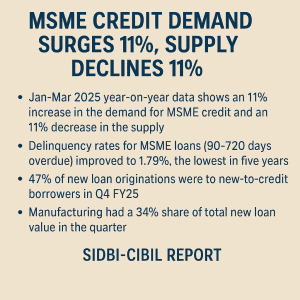New Delhi, May 23, 2025 – The latest MSME Pulse Report, jointly released by the Small Industries Development Bank of India (SIDBI) and TransUnion CIBIL, reveals a complex landscape for India’s Micro, Small, and Medium Enterprises (MSMEs) during the January–March 2025 quarter. While credit demand surged by 11% year-on-year (YoY), the supply of credit declined by an equivalent 11%, highlighting a growing mismatch between the financial needs of MSMEs and lenders’ risk appetite.
Demand-Supply Divergence
The report highlights a significant divergence between credit demand and supply. While commercial loan demand, measured by the number of credit inquiries, grew by 11% YoY in Q4 FY25, the actual disbursement of loans declined by 11% during the same period. This contraction is attributed to heightened credit concerns among lenders, possibly due to rising external economic headwinds.
Despite the quarterly decline, the overall commercial credit supply by value increased by 3% YoY for the fiscal year 2024-25.
Lender Performance
Public sector banks (PSBs), accounting for 39% of MSME credit demand, experienced a robust 15% YoY growth in loan demand during the quarter. In contrast, private sector banks, with a 42% share, saw an 8% increase. However, private banks witnessed a 14% YoY decline in credit supply, particularly affecting borrowers with exposures between ₹10 crore to ₹50 crore, especially in medium to long-term loans and overdraft facilities.
Credit Quality Improvement
The MSME sector’s credit quality showed notable improvement. Overall balance-level delinquencies (loans overdue by 90 days or more) fell to a five-year low of 1.79% as of March 2025, down from 2.1% in March 2024. This improvement was primarily driven by borrowers with exposures between ₹50 lakh and ₹50 crore. However, borrowers with exposures up to ₹10 lakh experienced an increase in delinquencies to 5.8% from 5.1% the previous year.
Sectoral and Regional Insights
The manufacturing sector accounted for 34% of the total loan origination value, despite representing only 23% of the number of new loans disbursed. However, the share of originations by value to the manufacturing sector has been declining, with a shift towards professional and other services, which now contribute to 36% of all loans disbursed by value.
Geographically, Maharashtra, Gujarat, Tamil Nadu, Uttar Pradesh, and Delhi dominated commercial lending, collectively accounting for 48% of the total loan origination value in Q4 FY25. While the manufacturing sector led in most of these states, Uttar Pradesh saw the highest originations in the trade sector.
New-to-Credit Borrowers
New-to-Credit (NTC) borrowers constituted 47% of all new loan originations in Q4 FY25. Public sector banks led in catering to this segment, offering 60% of NTC originations. The trade sector contributed the highest proportion of NTC borrowers at 53%, while the manufacturing sector witnessed the highest YoY growth (70%) in the number of NTC borrowers originating a commercial loan.
Conclusion
 The SIDBI-CIBIL MSME Pulse Report for May 2025 highlights a paradox in the MSME credit landscape: strong demand and improving asset quality juxtaposed with a contraction in credit supply. This scenario underscores the need for balanced risk assessment by lenders and supportive policy measures to ensure that MSMEs, the backbone of the Indian economy, have adequate access to financial resources for sustained growth.
The SIDBI-CIBIL MSME Pulse Report for May 2025 highlights a paradox in the MSME credit landscape: strong demand and improving asset quality juxtaposed with a contraction in credit supply. This scenario underscores the need for balanced risk assessment by lenders and supportive policy measures to ensure that MSMEs, the backbone of the Indian economy, have adequate access to financial resources for sustained growth.
For a comprehensive analysis, refer to the full report: MSME Pulse Report – May 2025 (PDF)
For more real time updates, visit Channel 6 Network.

